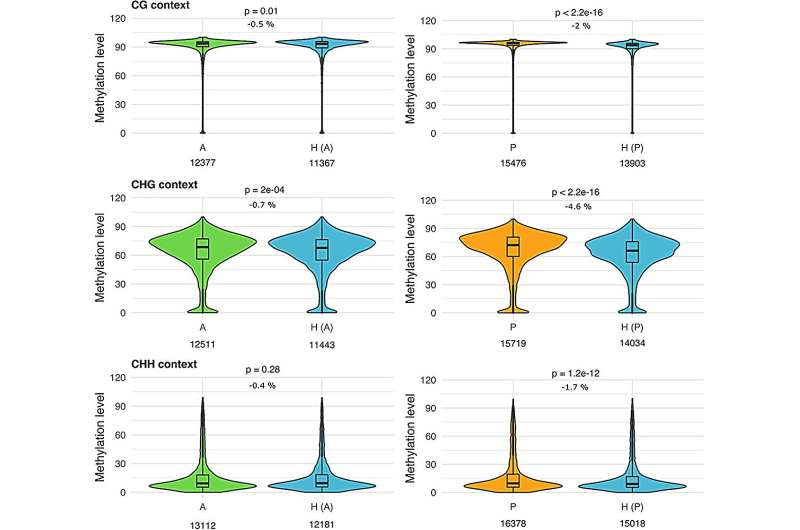This article has been reviewed according to Science X's editorial process and policies. Editors have highlighted the following attributes while ensuring the content's credibility:
fact-checked
peer-reviewed publication
proofread
Peach breeding research: Interspecific hybridization with almond shows minimal 'genomic shock'

Interspecific hybridization is a key process in plant evolution and breeding that can lead to phenotypic changes and the formation of new species. The merging of different genomes in a hybrid often triggers a so-called "genomic shock." These alterations include variation in gene expression and genome structure, particularly the activation of transposable elements (TEs).
TE activity is controlled by epigenetic mechanisms and DNA methylation is the most obvious and frequent chromatin modification associated to TE silencing. Similarly, some biotic and abiotic stresses can result in a decrease of the DNA methylation and can activate the TE transcription and mobilization. Therefore, hybridization often leads to TE activation, which can induce further changes in the genome.
However, the results of hybridization are not always predictable, as evidenced by the different transposable element activation in crosses between different species.
Peach (Prunus persica) exhibits low levels of genetic diversity, and interspecific hybridization with almonds (Prunus dulcis) is a potential source of novel alleles for peach breeding. Given the close genetic relationship and genomic homology between peach and almond, understanding what extend the crosses of the two species result in the activation of TEs that could lead to "genomic shock" is important for gaining insights into the broader effects of hybridization on plant breeding and evolution.
In May 2022, Horticulture Research published a research article titled "Absence of major epigenetic and transcriptomic changes accompanying an interspecific cross between peach and almond."
To understand potential changes in DNA methylation and gene transcription, particularly TEs, researchers employed whole-genome bisulfite sequencing of DNA from leaves of peach, almond, and their F1 hybrid.
The results showed differences in the methylation levels of the different classes of TEs but only minor differences when comparing the genomes of the hybrid with the genomes of the two parentals.
In spite of these minor differences, the methylation profile of the hybrid was more similar to the almond parental, with only a few exceptions such as LINEs in CHG or MITEs in CHH context. The study further explored differentially methylated regions (DMRs) between the hybrid and parental lines, focusing on LTR-retrotransposons. In all the cases, the percentages of DMRs with higher methylation in the hybrid respect to the parents are always around 50%, with a maximum difference of 59% in LTR retrotransposons.
RNA-seq analysis of mature leaves found significant differential transcription in 32 families: 11 LTR retrotransposon, 12 LINE and 9 TIR. The differential expression is mostly due to the differences between peach and almond, and the hybrid's expression typically being intermediate.
Lastly, they analyzed the changes in gene expression in the hybrid, by mapping RNA-seq reads from peach, almond and the hybrid to a single gene model dataset. The majority of genes (78.3%) had similar transcription levels across all three genotypes.
Some genes had higher expression in one parent compared to the other, with the hybrid often showing intermediate or parent-like expression. Notably, only a small fraction of genes showed higher or lower expression in the hybrid.
In summary, this research reveals that contrary to the "genomic shock" expectations, there is no significant changes in DNA methylation or transcription levels of transposable elements in the hybrid compared to its parents. Additionally, gene expression alteration in the hybrid is minimal.
These findings suggest that the genomic merger does not induce major regulatory upheavals, highlighting the potential for using such interspecific crosses in peach breeding to introduce new genetic variability without significant genomic instability.
More information: Carlos de Tomás et al, Absence of major epigenetic and transcriptomic changes accompanying an interspecific cross between peach and almond, Horticulture Research (2022). DOI: 10.1093/hr/uhac127
Journal information: Horticulture Research
Provided by Plant Phenomics




















